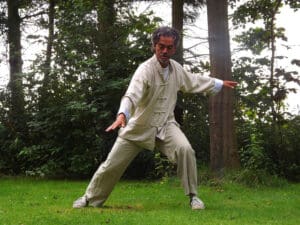Stressed Out? Try This
Today, I’d like to present Dr. Andrew Weil’s article of Qigong. How this renowned Western doctor sees this ancient chinese exercise in the light of Western medicine.
This 3,000-year-old discipline from China has been called the hottest trend in stress relief by the Wall Street Journal, but qigong (pronounced chee gung) isn’t just a relaxation technique. Combining slow movement, deep breathing, and meditation, qigong is also a gentle form of exercise that promotes flexibility and increases strength without stressing the joints. And it can be a useful therapy for a variety of ailments. What’s more, qigong is suitable for people of all ages and can be done safely by those with physical limitations.
What to expect
The aim of qigong is to strengthen or balance the flow of vital energy (qi) throughout the body’s invisible channels called meridians.(Qigong means cultivating energy.)A typical qigong class lasts an hour, and requires no special clothes, although you may be asked to remove your shoes.To begin, the instructor may have you stand or sit, and lead you in meditation and breathing techniques to help quiet your mind and body so you can recognize the qi moving through your body.
Then you may proceed to movement exercises involving the arms and legs. Although the nonstrenuous movements resemble those of tai chi, they often consist of shorter sequences, which are easy to learn and practice. The different sets of exercises have evocative names like Five Animal Frolics and Eight Pieces of Brocade. The class may end with more meditation, leaving you feeling both relaxed and energized.
Between classes, daily practice at home is recommended; for beginners, 30 minutes a day is plenty, and even 10 minutes a day is fine.
Some people may find that they can feel their qi (for instance, they might have a sensation of tingling or warmth in their hands) within minutes of first practicing qigong. Even so, if you’re practicing qigong to help treat one of the health conditions mentioned below, it may take a couple months of daily practice to notice changes in your symptoms.
Who may benefit
Older people may find it helpful for maintaining flexibility, balance, and general vitality. Plus, research in Asia suggests that practicing qigong regularly can lower blood pressure, reduce the frequency and severity of asthma attacks, promote the healing of ulcers, reduce arthritis pain, and even enhance immunity.
In China, qigong is recommended to cancer patients to reduce fatigue and other side effects of conventional cancer treatments.
So far, there’s been little research on qigong in the United States.One trail found it reduced both pain and anxiety in people with complex regional pain syndrome, a disabling neurological disorder.
Researchers here at the University of Arizona are now studying whether qigong can improve cardiovascular health and reduce depression in patients with artificial hearts who are waiting for a heart transplant.

